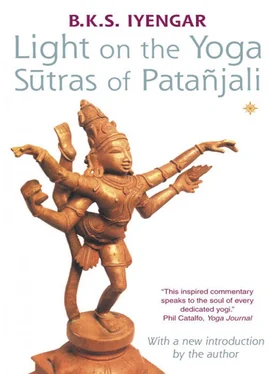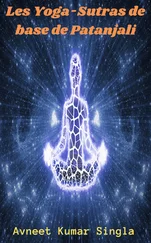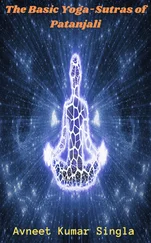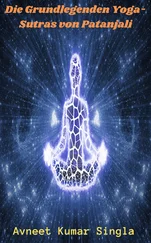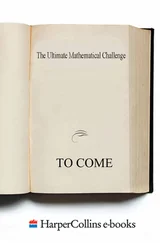This chapter deals with the necessary rejection by yogis of the supernatural powers which attend their spiritual ascent, and indicates how such men and women, who have in a sense left the world behind, may then serve the world.
Kaivalya pada opens with the contention that prodigious yogic powers may be inborn, acquired by merit accumulated through practice in former lives. They may also be attained through use of herbs ( ausadhi ), incantation ( mantra ), devoted discipline ( tapas ), meditation ( dhyana ) and total absorption ( samadhi).
In these five types of yogis, nature’s energy, which later becomes known as kundalini, flows with ever-increasing abundance, preparing them to receive the infinite light of the soul. If misused, this energetic current will vanish, after destroying its user. This is why tapas and samadhi are held to be the best of the five: they provide a firm foundation for stable growth, which prevents the yogi from misusing the energy built up through his practices.
The yogi’s judicious use of natural forces can be compared to the farmer who floods his fields one by one within their earthen banks, letting the water thoroughly drench the soil before breaking open a new channel into another. For safety’s sake, the yogi employs method and restraint so as to use nature’s energy (sakti) intelligently to gain wisdom.
It takes talent to grasp nature’s potential and measure its use. The danger is that power leads to pride and builds ego, eclipsing one’s essential divinity. The root of the ego is the same pure consciousness; it is its contact with external phenomena that generates desire, the seed of impurity. Purity is humility. When sullied by cleverness it becomes pride, which causes consciousness to dissipate itself in the fluctuations of thought. Tapas and samadhi are the most reliable means to acquire yogic talent.
Actions are of four types. They are black, white, grey, or without these attributes. The last is beyond the gunas of rajas, tamas and sattva , free from intention, motivation and desire, pure and sourceless, and outside the law of cause and effect that governs all other actions. Motivated action leads eventually to pride, affliction and unhappiness; the genuine yogi performs only actions which are motiveless: free of desire, pride and effect.
The chain of cause and effect is like a ball endlessly rebounding from the walls and floor of a squash court. Memory, conscious or sublimated, links this chain, even across many lives. This is because every action of the first three types leaves behind a residual impression, encoded in our deepest memory, which thereafter continues to turn the karmic wheel, provoking reaction and further action. The consequences of action may take effect instantaneously, or lie in abeyance for years, even through several lives. Tamasic action is considered to give rise to pain and sorrow, rajasic to mixed results, and sattvic to more agreeable ones. Depending on their provenance, the fruits of action may either tie us to lust, anger and greed, or turn us towards the spiritual quest. These residual impressions are called samskaras: they build the cycles of our existence and decide the station, time and place of our birth. The yogi’s actions, being pure, leave no impressions and excite no reactions, and are therefore free from residual impressions.
Desires, and knowledge derived from memory or residual impressions, exist eternally. They are as much a part of our being as is the will to cling to life. In a perfect yogi’s life, desires and impressions have an end; when the mechanism of cause and effect is disconnected by pure, motiveless action, the yogi transcends the world of duality and desires and attachment wither and fall away.
Yogic discipline eradicates ignorance, avidya. When illusion is banished, time becomes timeless. Though time is a continuum, it has three movements: past, present and future. Past and future are woven into the present and the present is timeless and eternal. Like the potter’s wheel, the present – the moment – rolls into movement as day and night, creating the impression that time is moving. The mind, observing the movement of time, differentiates it as past, present and future. Because of this, the perception of objects varies at different times.
Though the permanent characters of time, the object and the subject remain in their own entities, the mind sees them differently according to the development of its intelligence, and creates disparity between observation and reflection. Hence, actions and fulfilments differ. An illustration of this would be that we recognize the difference between what is involved when a murderer kills for money, a soldier kills for his country and a man kills defending his family against bandits. It is all killing, but the implications are radically different in each case, according to the development of the individual.
The yogi is alert to, and aware of, the present, and lives in the present, using past experience only as a platform for the present. This brings changelessness in the attitude of the mind towards the object seen.
Earlier chapters point out that whereas nature is eternal, its qualities or gunas, are ever-changing. This blending of the gunas creates diversity in the mind so that it sees objects in different ways. The object is the same and the mind, too, is the same. But the same mind has many qualities of mood and behaviour. This fragmentation is the cause of avidya. The mind divided by the gunas moulds and remoulds man. As the gunas move in rhythmic unity, intellectual development differs qualitatively in each person and each one sees objects differently, though their essence does not change.
The yogi studies the uniqueness of that rhythmic mutation, keeps aloof from it, and rests in his own essence, his soul. This essence, and the essence of the perceived object, are the same for him. Through self-examination, he realizes that objects do not change, but that he himself fabricates their apparent changes. He learns to perceive without prejudice, aware that objects exist independently, irrespective of his cognition of them. His clear, unpolluted mind sees objects as they are, separate from him and therefore unable to leave an impression on him. Being free from bias, he is free from karma.
Cit and citta (universal and individual consciousness)
The unalterable seer ( cit ) is the Lord of the consciousness. He is ever-present, changeless, constant, ever-luminous. The seer can be both subject and object at the same time. He is aware of all mutations taking place in his mind, intelligence and consciousness. He knows that they are his products and that they may taint him as long as avidya and asmita survive.
The seer is the seed, and consciousness the seedling. Mind is the stem, and vrittis , the fluctuations or thought-waves, are the leaves, relayed via mind through the single consciousness, the stem, back to the seed.
Consciousness and its branches, intelligence, mind and thought, become objects of the seer. The branches have no existence of their own without consciousness, and consciousness has none without the seer. It borrows light from the seer and extends towards intelligence, mind and thought. As it is not self-illumined it cannot be at once subject and object. It is a knowable object to the seer just as the objects of the world are knowable to it.
Читать дальше
